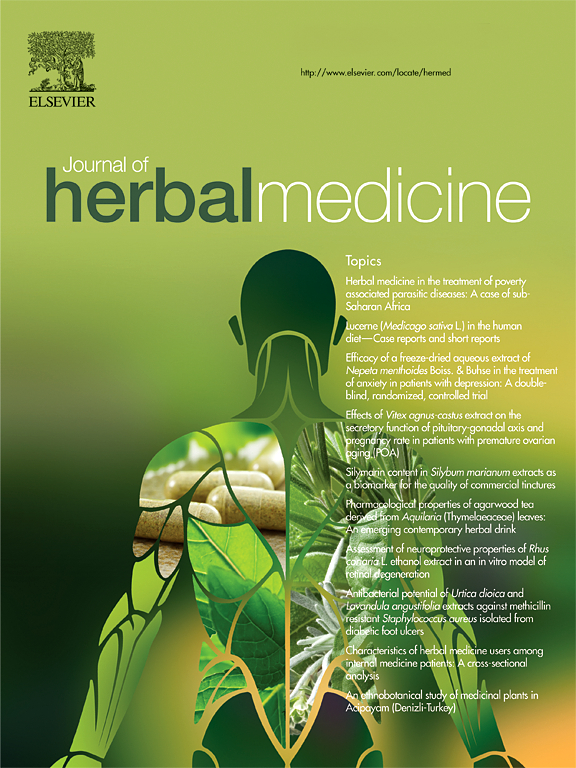Unravelling the Anti-inflammatory Potential of Mitragyna parvifolia: A Mechanistic and Data-Driven Approach to Herbal Medicine
IF 1.9
4区 医学
Q2 INTEGRATIVE & COMPLEMENTARY MEDICINE
引用次数: 0
Abstract
Introduction
Inflammation is a protective physiological response, but its chronic manifestation leads to adverse health outcomes. Current anti-inflammatory treatments often have significant side effects, necessitating safer alternatives. Mitragyna parvifolia, a medicinal plant, has demonstrated anti-inflammatory potential, though its mechanisms remain underexplored. The current study was designed to explore the anti-inflammatory mechanisms of M parvifolia, emphasising its potential as therapeutic agent for inflammatory diseases.
Methods
This study employed in silico approaches, including network pharmacology, molecular docking, and molecular dynamic simulations, to identify interactions between M parvifolia phytocompounds and inflammatory targets. Experimental validation was conducted using supercritical CO2 leaf extract, evaluated for cytotoxicity, protein denaturation, COX-2 inhibition, and HRBC membrane stabilisation and phytochemical profiling using LC-QTOF-MS analysis.
Results
Thirteen phytocompounds of M parvifolia were found to modulate 97 inflammatory targets, significantly impacting Interleukin-17 and TNF signalling pathways. Molecular docking revealed strong binding of compounds to key targets, including MMP9 and PTGS2, with the MMP9-Corynan-17-ol complex showing the highest stability in simulations. LC-QTOF-MS analysis identified 10 major bioactive constituents, supporting in silico predictions. Experimental assays confirmed low cytotoxicity (>90% cell viability) and demonstrated potent anti-inflammatory effects: 73.71% ± 1.5% inhibition of COX-2 activity, 73.9% ± 0.4% inhibition of protein denaturation, and 75.5% ± 0.83% HRBC membrane stabilisation at maximum concentrations.
Conclusions
M parvifolia exhibits significant anti-inflammatory properties through modulation of key pathways and targets, combined with strong experimental validation of its efficacy and safety. These findings position M parvifolia as a promising candidate for developing natural, safer anti-inflammatory therapies.

揭示小叶密天竺的抗炎潜力:一种机制和数据驱动的草药方法
炎症是一种保护性生理反应,但其慢性表现会导致不良的健康结果。目前的抗炎治疗通常有明显的副作用,需要更安全的替代品。药用植物米特拉古纳(Mitragyna parvifolia)已显示出抗炎潜力,但其机制仍未得到充分探索。本研究旨在探讨小叶草的抗炎机制,强调其作为炎症性疾病治疗剂的潜力。方法采用网络药理学、分子对接、分子动力学模拟等方法,研究细叶草化合物与炎症靶点的相互作用。实验验证使用超临界CO2叶提取物,评估细胞毒性,蛋白质变性,COX-2抑制和HRBC膜稳定性,并使用LC-QTOF-MS分析植物化学谱。结果发现13种植物化合物可调节97个炎症靶点,显著影响白细胞介素-17和TNF信号通路。分子对接揭示了化合物与关键靶点的强结合,包括MMP9和PTGS2,其中MMP9- coryan -17-ol复合物在模拟中表现出最高的稳定性。LC-QTOF-MS分析鉴定出10种主要生物活性成分,支持计算机预测。实验分析证实了低细胞毒性(>;90%细胞活力)和有效的抗炎作用:在最大浓度下,COX-2活性抑制73.71% ± 1.5%,蛋白变性抑制73.9% ± 0.4%,HRBC膜稳定75.5% ± 0.83%。结论小檗通过调节关键通路和靶点具有明显的抗炎作用,其有效性和安全性得到了有力的实验验证。这些发现使细小分枝杆菌成为开发天然、更安全的抗炎疗法的有希望的候选者。
本文章由计算机程序翻译,如有差异,请以英文原文为准。
求助全文
约1分钟内获得全文
求助全文
来源期刊

Journal of Herbal Medicine
INTEGRATIVE & COMPLEMENTARY MEDICINE-
CiteScore
3.90
自引率
0.00%
发文量
94
期刊介绍:
The Journal of Herbal Medicine, the official journal of the National Institute of Medical Herbalists, is a peer reviewed journal which aims to serve its readers as an authoritative resource on the profession and practice of herbal medicine. The content areas of the journal reflect the interests of Medical Herbalists and other health professionals interested in the clinical and professional application of botanical medicines. The objective is to strengthen the research and educational base of herbal medicine with research papers in the form of case studies, original research articles and reviews, monographs, clinical trials and relevant in vitro studies. It also publishes policy statements, opinion pieces, book reviews, conference proceedings and profession related information such as pharmacovigilance reports providing an information source for not only the Herbal Practitioner but any Health professional with an interest in phytotherapy.
 求助内容:
求助内容: 应助结果提醒方式:
应助结果提醒方式:


